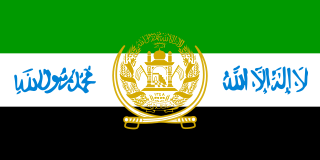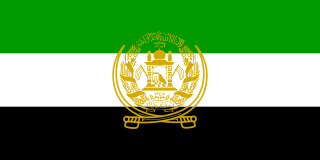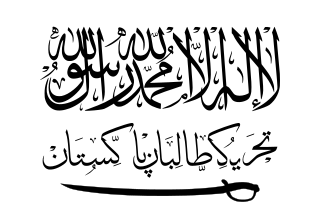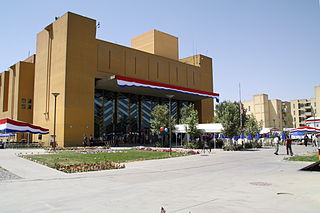
The Taliban or Taleban, who refer to themselves as the Islamic Emirate of Afghanistan (IEA), is a Deobandi Islamist movement and military organization in Afghanistan, currently waging war within the country. Since 2016, the Taliban's leader has been Mawlawi Hibatullah Akhundzada.

Mullah Mohammed Omar was an Afghan mujahideen commander who led the Taliban, and founded the Islamic Emirate of Afghanistan in 1996.

Kunduz is a city in northern Afghanistan, the capital of Kunduz Province. The city has a population of about 374,746, making it about the 6th-largest city of Afghanistan, and the largest city in the northeastern section of the country. Kunduz is in the historical Tokharistan region of Bactria, near the confluence of the Kunduz River with the Khanabad River. Kunduz is linked by highways with Kabul to the south, Mazar-i-Sharif to the west, and Badakhshan to the east. Kunduz is also linked with Dushanbe in Tajikistan to the north, via the Afghan dry port of Sherkhan Bandar.

The Islamic State of Afghanistan was the government of Afghanistan, established by the Peshawar Accords on 26 April 1992 by many, but not all, Afghan mujahideen parties, after the fall of the communist government. Its power was limited due to civil war. From 1996, it became a government in exile when the Taliban took power of Kabul and established the mostly unrecognized Islamic Emirate of Afghanistan. The Islamic State was in control of the country again after the Taliban government was overthrown by the United States in 2001 after the invasion. In 2002 it was succeeded by the Transitional Islamic State of Afghanistan.

The Afghan Northern Alliance, officially known as the United Islamic Front for the Salvation of Afghanistan, was a united military front that came to formation in late 1996 after the Islamic Emirate of Afghanistan (Taliban) took over Kabul. The United Front was assembled by key leaders of the Islamic State of Afghanistan, particularly president Burhanuddin Rabbani and former Defense Minister Ahmad Shah Massoud. Initially it included mostly Tajiks but by 2000, leaders of other ethnic groups had joined the Northern Alliance. This included Karim Khalili, Abdul Rashid Dostum, Abdullah Abdullah, Mohammad Mohaqiq, Abdul Qadir, Asif Mohseni and others.

The Taliban insurgency began after the group's fall from power during the 2001 War in Afghanistan. The Taliban forces are fighting against the Afghan government, formerly led by President Hamid Karzai, now led by President Ashraf Ghani, and against the US-led International Security Assistance Force (ISAF). The insurgency has spread to some degree over the Afghanistan-Pakistan border to neighboring Pakistan, in particular Khyber Pakhtunkhwa. The Taliban conduct warfare against Afghan National Security Forces and their NATO allies, as well as against civilian targets. Regional countries, particularly Pakistan, Iran, China and Russia, are often accused of funding and supporting the insurgent groups.

The following items form a partial timeline of the War in Afghanistan. For events prior to October 7, 2001, see 2001 in Afghanistan.

Tehrik-i-Taliban in Pakistan, alternatively referred to as the Pakistani Taliban or TTP in short, is a far right Islamist Pashtun terrorist armed group that is an umbrella organization of various militant groups based along the Afghan–Pakistani border. Most Taliban groups in Pakistan coalesce under the TTP. In December 2007 about 13 groups united under the leadership of Baitullah Mehsud to form the TTP. Among the stated objectives of TTP is resistance against the Pakistani state. The TTP's aim is to overthrow the government of Pakistan by waging a terrorist campaign against the Pakistan armed forces and the state. The TTP depends on the tribal belt along the Afghanistan-Pakistan border from which to draw its recruits. The TTP draws ideological guidance from al-Qaeda and maintains ties with al-Qaeda.

The War in Afghanistan is an ongoing war following the United States invasion of Afghanistan when the United States and its allies successfully drove the Taliban from power in order to deny al-Qaeda a safe base of operations in Afghanistan. After the initial objectives were completed, a coalition of over 40 countries formed a security mission in the country called International Security Assistance Force of which certain members were involved in military combat allied with Afghanistan's government. The war has mostly consisted of Taliban insurgents fighting against the Afghan Armed Forces and allied forces; the majority of ISAF/RS soldiers and personnel are American. The war is code-named by the U.S. as Operation Enduring Freedom (2001–14) and Operation Freedom's Sentinel (2015–present).

The Afghanistan conflict is a series of wars that has been fought in Afghanistan since 1978. Starting with the Saur Revolution military coup, an almost continuous series of armed conflicts has dominated and afflicted Afghanistan. The wars include:
The Battle of Kandahar was an attack by Taliban forces on May 7, 2011, in the city of Kandahar. The battle was part of the 2011 Taliban Spring Offensive. The battle was the biggest Taliban offensive of 2011, marking over 40 total deaths and over 50 total wounded. The fighting demonstrated that, despite heavy losses since 2001, the Taliban forces remain a threat to coalition and Afghan forces, and show that morale in insurgent groups has not died since the death of Bin Laden.

On 5 August 2011, a U.S. CH-47D Chinook military helicopter operating with the call sign Extortion 17 was shot down while transporting a Quick Reaction Force attempting to reinforce a Joint Special Operations Command unit of the 75th Ranger Regiment in the Tangi Valley in Maidan Wardak province, southwest of Kabul, Afghanistan. The resulting crash killed all 38 people on board – 23 US Navy SEALs, 2 United States Air Force Pararescue, 1 United States Air Force Combat Control Team member, one pilot and two crewmen of the United States Army Reserve, one pilot and one crewman of the United States Army National Guard, seven members of the Afghan National Security Forces, and one Afghan interpreter, as well as a U.S. military working dog. At 31 U.S. military personnel killed, the shoot down of Extortion 17 represents the greatest single-incident loss of U.S. lives in Operation Enduring Freedom – Afghanistan, surpassing the sixteen lost in the downing of Turbine 33, a 160th Special Operations Aviation Regiment (Airborne) MH-47, during Operation Red Wings on 28 June 2005.

The April 2012 Afghanistan attacks took place on Sunday, 15 April 2012, at around 13:00 local time when heavily armed Taliban insurgents and suicide bombers launched multiple coordinated attacks throughout Afghanistan. Insurgents launched the 2012 spring offensive on multiple locations, including government buildings, military bases, and embassies. Attacks occurred in four Afghan provinces, including Kabul and Paktia. Different reports attribute responsibility for the attacks to either Taliban or the Haqqani network although the Taliban have claimed responsibility.

The 2013 Afghan presidential palace attack occurred on 25 June 2013, in a highly secure zone of Kabul, the capital city of Afghanistan.
The following lists events that happened in 2013 in Afghanistan.
Events in the year 2017 in Afghanistan.
The Afghan peace process comprises the proposals and negotiations in a bid to end the ongoing war in Afghanistan. Although sporadic efforts have taken place since the war began in 2001, negotiations and the peace movement intensified in 2018 amid talks between the Taliban, which is the main insurgent group fighting against the Afghan government and American troops; and the United States, of which thousands of soldiers maintain a presence within the country to support the Afghan government. Besides the United States, major powers such as China, India, Pakistan, Russia, as well as NATO play a part that they see as facilitating the peace process, while the Afghan peace group People's Peace Movement sees regional and global powers as a cause of continued war.
This article summarizes the history of the War in Afghanistan (2001–present).

In a continuation of previous attacks by the Taliban in May and June, multiple clashes between Afghan security forces and the Taliban were reported. They carried out several attacks throughout Afghanistan, resulting in multiple fatalities on both sides. Both the Taliban and government forces have accused each other responsibility over the recent surge in violence across Afghanistan. The attacks come despite the signing of a peace deal with the U.S. in February that was intended to put an end to the war.















